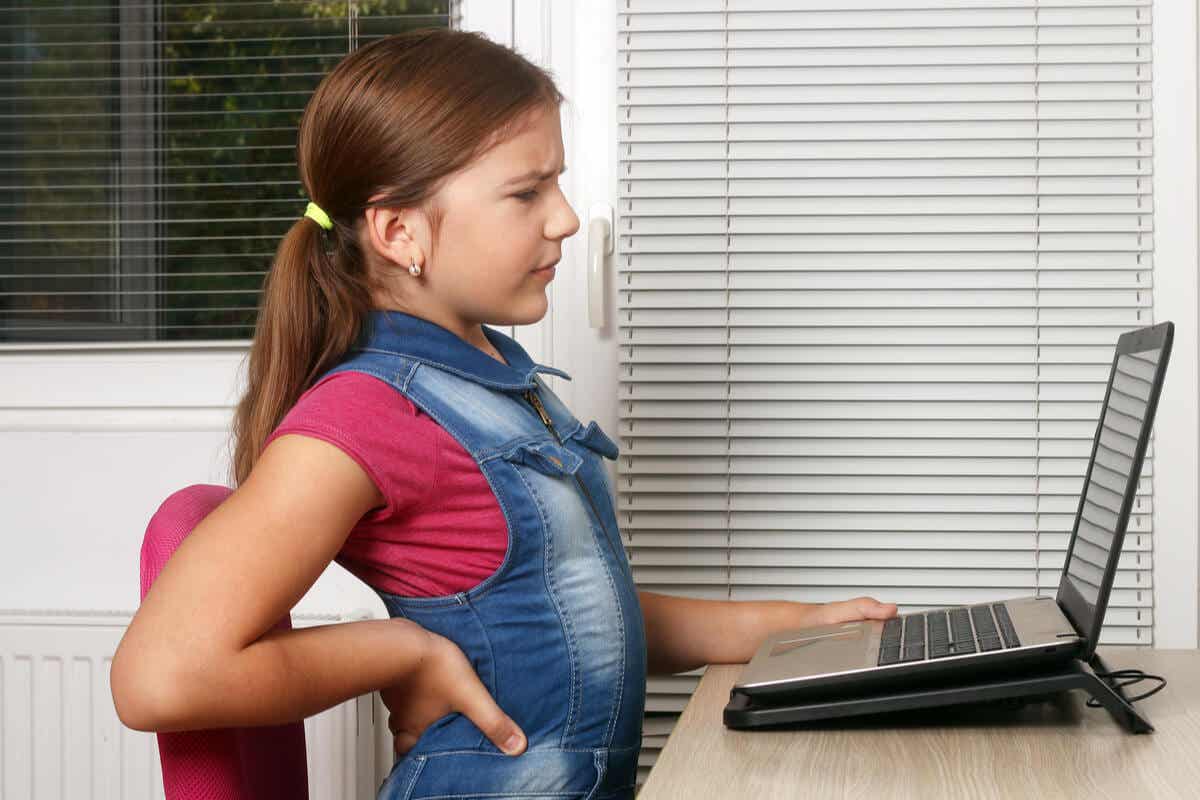Back Pain in Children: What to Do (and Not Do)

Few sensations are as annoying as back pain in children, a symptom that can range from sporadic and mild to severe in a small minority of cases. Whatever the case, medical evaluation is always important. However, there are some factors you can modify at home to improve the quality of life of children.
Likewise, there are some behaviors you should avoid in order not to worsen the situation or produce other effects. For example, you should never resort to self-medication. In the following article, we’ll talk about the most general aspects, causes and behaviors you should follow in case of back pain in children. Keep reading!
Why does back pain in children occur?

According to a publication in Comprehensive Pediatrics in 2014, back pain in children can be the result of multiple pathological and non-pathological conditions. In fact, according to estimates, 95-99% of cases have no association with a particular disease or event, known as “nonspecific pain.”
In this important proportion of children, there may be associated factors that explain, in part, the pain. For example, abundant physical activity (or lack thereof), obesity, and the misuse of backpacks in schools are some representative examples.
In a few cases, there are diseases capable of causing this problem. They’re much less common than in adults, where certain pathologies such as arthritis are frequent in health centers. Some of these diseases are the following:
- Herniated disc: When a structure of the spine called “intervertebral disc” protrudes or goes outside the normal limits and therefore compresses or irritates a nerve, causing the symptoms. It’s more common in adolescents than in young children.
- Spinal tumors: These can be divided into benign and malignant. In general, they’re rare, although there are malignant bone tumors that are more common in children than in adults.
- Deformities: This is typically the case of scoliosis, a pathology in which the spine deviates to one side or the other.
Find out more: Painful Pronation of the Elbow in Children: What to Do?
What should be done about back pain in children?
As we’ve already mentioned, back pain in children can be frequent, but rarely is it caused by serious pathologies. Before going to the doctor, it’s worth reflecting on those situations or behaviors that could be influencing the onset of pain. In this sense, you can take into consideration the following:
- Does the pain start at any specific time of the day?
- Is the weight of your child’s school bag too heavy? Are they putting it on correctly?
- Does the child exercise a lot? Or, on the contrary, is your child characteristically sedentary?
- Are you noticing any problems with depression, ongoing sadness, or school isolation?
In most cases, the answer to at least one of these questions will be yes. Therefore, from home, there are ways you can intervene to improve some of these “risk factors” and reduce the intensity and frequency of pain.
What not to do
In most cases, it’s tempting to give the child some painkiller commonly used at home (such as paracetamol or ibuprofen). While many of these medications are available over-the-counter and are safe, it’s important to keep these things in mind for your child:
- Their age
- The intensity of the pain
- Possible allergies to medications
Self-medication (or, in this case, the administration of medication without a doctor’s prescription or recommendation) isn’t recommended. For this reason, it’s more than advisable to make a brief consultation with a pediatrician or family physician.

Find out more: Should You Alternate Paracetamol and Ibuprofen in Children?
Is it always necessary to go to the doctor?
If the pain attracts a lot of attention from the parents or represents a problem in the child’s life, it’s best to go to the doctor as soon as possible. This consultation can be planned with sufficient time in the case it’s a very sporadic sensation and of slight intensity.
In principle, it’s best to consult a pediatrician or family doctor, depending on the child’s age or where you live. If necessary, any of them could refer you to another specialist such as a neurosurgeon, traumatologist, or orthopedist.
What are the warning signs?
In case of increased volume in the spine, constant fever, generalized pain throughout the body and radiating to the legs, obesity, or behavioral problems related to depression, it’s important to see a doctor as soon as possible. There’s likely to be an underlying condition that needs to be diagnosed.
A common symptom, but one you shouldn’t neglect
Back pain in children can be a real nuisance, including for parents who are naturally concerned about their children’s state of health. As we’ve been mentioning, in most cases, it’s due to behavioral or emotional problems that could improve with some changes at home.
To find out for sure, going to a medical specialist will always be the best option. Try to write down somewhere the answers to the questions we’ve asked, and also bring along any recent lab work or studies that have been done for any reason.
Few sensations are as annoying as back pain in children, a symptom that can range from sporadic and mild to severe in a small minority of cases. Whatever the case, medical evaluation is always important. However, there are some factors you can modify at home to improve the quality of life of children.
Likewise, there are some behaviors you should avoid in order not to worsen the situation or produce other effects. For example, you should never resort to self-medication. In the following article, we’ll talk about the most general aspects, causes and behaviors you should follow in case of back pain in children. Keep reading!
Why does back pain in children occur?

According to a publication in Comprehensive Pediatrics in 2014, back pain in children can be the result of multiple pathological and non-pathological conditions. In fact, according to estimates, 95-99% of cases have no association with a particular disease or event, known as “nonspecific pain.”
In this important proportion of children, there may be associated factors that explain, in part, the pain. For example, abundant physical activity (or lack thereof), obesity, and the misuse of backpacks in schools are some representative examples.
In a few cases, there are diseases capable of causing this problem. They’re much less common than in adults, where certain pathologies such as arthritis are frequent in health centers. Some of these diseases are the following:
- Herniated disc: When a structure of the spine called “intervertebral disc” protrudes or goes outside the normal limits and therefore compresses or irritates a nerve, causing the symptoms. It’s more common in adolescents than in young children.
- Spinal tumors: These can be divided into benign and malignant. In general, they’re rare, although there are malignant bone tumors that are more common in children than in adults.
- Deformities: This is typically the case of scoliosis, a pathology in which the spine deviates to one side or the other.
Find out more: Painful Pronation of the Elbow in Children: What to Do?
What should be done about back pain in children?
As we’ve already mentioned, back pain in children can be frequent, but rarely is it caused by serious pathologies. Before going to the doctor, it’s worth reflecting on those situations or behaviors that could be influencing the onset of pain. In this sense, you can take into consideration the following:
- Does the pain start at any specific time of the day?
- Is the weight of your child’s school bag too heavy? Are they putting it on correctly?
- Does the child exercise a lot? Or, on the contrary, is your child characteristically sedentary?
- Are you noticing any problems with depression, ongoing sadness, or school isolation?
In most cases, the answer to at least one of these questions will be yes. Therefore, from home, there are ways you can intervene to improve some of these “risk factors” and reduce the intensity and frequency of pain.
What not to do
In most cases, it’s tempting to give the child some painkiller commonly used at home (such as paracetamol or ibuprofen). While many of these medications are available over-the-counter and are safe, it’s important to keep these things in mind for your child:
- Their age
- The intensity of the pain
- Possible allergies to medications
Self-medication (or, in this case, the administration of medication without a doctor’s prescription or recommendation) isn’t recommended. For this reason, it’s more than advisable to make a brief consultation with a pediatrician or family physician.

Find out more: Should You Alternate Paracetamol and Ibuprofen in Children?
Is it always necessary to go to the doctor?
If the pain attracts a lot of attention from the parents or represents a problem in the child’s life, it’s best to go to the doctor as soon as possible. This consultation can be planned with sufficient time in the case it’s a very sporadic sensation and of slight intensity.
In principle, it’s best to consult a pediatrician or family doctor, depending on the child’s age or where you live. If necessary, any of them could refer you to another specialist such as a neurosurgeon, traumatologist, or orthopedist.
What are the warning signs?
In case of increased volume in the spine, constant fever, generalized pain throughout the body and radiating to the legs, obesity, or behavioral problems related to depression, it’s important to see a doctor as soon as possible. There’s likely to be an underlying condition that needs to be diagnosed.
A common symptom, but one you shouldn’t neglect
Back pain in children can be a real nuisance, including for parents who are naturally concerned about their children’s state of health. As we’ve been mentioning, in most cases, it’s due to behavioral or emotional problems that could improve with some changes at home.
To find out for sure, going to a medical specialist will always be the best option. Try to write down somewhere the answers to the questions we’ve asked, and also bring along any recent lab work or studies that have been done for any reason.
All cited sources were thoroughly reviewed by our team to ensure their quality, reliability, currency, and validity. The bibliography of this article was considered reliable and of academic or scientific accuracy.
- García C. Dolor de espalda. Pediatr Integral 2014;XVIII(7):413-424.
This text is provided for informational purposes only and does not replace consultation with a professional. If in doubt, consult your specialist.








